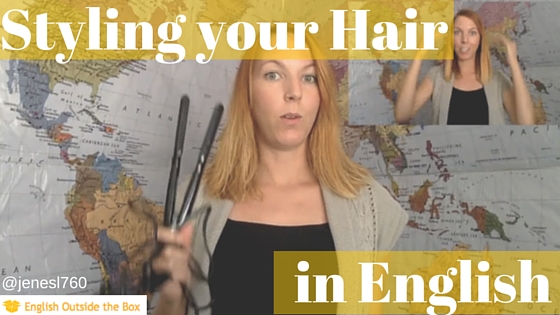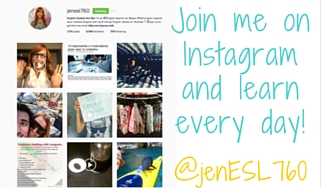
How to Talk about Styling your Hair in English
Let’s face it (*let’s be honest*), there are a lot of things you need to study to reach fluency in English. It is easy to focus on the things that seem the most important: business vocabulary, important grammar topics, pronunciation points, improving listening with news and current events, etc..; however, students often forget about the basic vocabulary and everyday actions they do.
It is this vocabulary, the “easy” stuff, the basic everyday actions that students don’t think about or study consistently. And just like everything in life, if we don’t use it, we lose it. This means that if you don’t study and use this language, you will forget it and not be able to use it in conversations.
This is why today’s post gives extra special attention to something that most of us do every day, styling our hair. In today’s “5 Minute English” video lesson, I will teach you how to talk about hair in English, including the necessary vocabulary to talk about styling your hair. I’ll also teach you the tools and products needed, and the names of different hairstyles.
This video and lesson will help you if you want to..
-
visit the hairdresser/hair salon and talk to your hair stylist about what you want
-
increase your vocabulary on everyday, real (English) language
-
teach this topic to your ESL class (use as supplemental material)
Before reading, you can watch the 5 Minute English video here to improve listening comprehension and review the vocabulary of today’s post. When you finish, the rest of this article will support you with examples and written explanation.
Styling your Hair in English
Step 1: Getting out of the shower
Vocabulary in the video:
* sopping wet: very wet (sopping is an adjective)
* soaking wet: very wet (soaking is an adjective)
* knots [noun]: tangled hair (see a bad knot I had here)
* brush [noun]: a tool with many rows/layers of bristles for smoothing out hair and removing knots
* comb [noun]: a flat tool with 1 thin row of teeth (plastic/metal bristles) that are close together and used for smoothing out hair and removing knots
* wide tooth comb [noun]: a flat tool with 1 thin row of teeth (plastic/metal bristles) that are far apart (WIDE) and used for smoothing out hair and removing knots
When you get out of the shower you need to dry your hair. Many people will wrap their hair in a towel to dry or towel dry their hair, which means they use a towel to squeeze the moisture out of their hair as seen in the video. Before you can dry it, you need to brush out the knots so it’s not too unruly (*messy*) when it dries completely.
Step 2: Drying your hair
It is easy to dry your hair completely when it’s not soaking wet and full of knots. So when you finish towel drying and brushing out the knots you have two options for completely drying your hair. You can air dry your hair, let it dry naturally with the outside air, or you can blow dry your hair, use an electric tool to blow out hot air on your hair.
When you blow dry your hair, it’s easier to set the shape you want it to be. On the contrary, when you air dry your hair, it it often frizzy (*tightly curled*) or puffy (*larger than desired*). You can see around minute 1:36 of the video how frizzy or puffy hair looks on me!
Step 3: Styling your hair
Vocabulary in the video:
* straighten [verb]: to make something (hair) straight with no curves, kinks, curls or bends
* curl [verb]: to make something (hair) have a curved or rounded shape
* bangs [noun]: (always plural) the short hair covering one’s forehead; in British English: fringe
* to grow (hair) out [phrasal verb]: to allow hair to become/get longer
* layered hair [adjective + noun]: hair that is cut into different lengths from the base (the top) to the bottom (see an image here)
* body [noun]: hair that seems thicker and fuller
* volume [noun]: “taller” hair roots (*the base hair*), roots that are not flat
* wavy curls [adjective + noun]: curls that are loose and more natural looking
Look #1: Straightened
In order to straighten your hair, you need a tool called a straightener, flat iron, or hot iron. All 3 of these terms are used interchangeably, which means they have no difference in meaning. Although, I will note that “hot iron” is not very common.
As I mentioned above and in the video, when you straighten your hair you remove the curves and kinks, and also eliminate the frizziness and puffiness (definitions above in step 2). To describe this action you can say, “I straightened my hair.” In order to do the action, you put the tool closest to the base (*the top*) of your head as possible, and you run it down to the tip/end.
Look #2: Curled
In order to curl your hair, you need a tool called a curling iron or a wand. Both of these tools look the same; however, a wand is just a metal rod and does not have the open/close clamp to hold hair like a curling iron has.
Using these tools gives your hair a rounded shape for added texture. Traditionally, with a curling hair you put hair into the clamp and curl or wind it up to the root. Hold the hair there, allowing the heat to give it the bend, and release. However, as I mentioned in the video a trend nowadays is to use a wand. With a wand, you just take a piece/strand of hair and wrap it around the rod from the base of the hair to the end. You can see me use my curling iron like a wand in the video. The wand gives it a more natural or “beachy” look, which means looser curls.
Hair Products
Hair products are used to make your hair “do” something, and each product has its own special use. The products mentioned in this video are:
* hairspray: used to make the hair hold its shape, not fall flat or lose its curl
* sea salt texturizing spray: a spray with salt (+ other ingredients) used to give hair more texture and not feel “so clean” and shiny
* volumizing spray: used to give roots (the base hair) more volume, to appear “taller”
* dry shampoo: a powder spray used to soak up extra oil on the head and hair, used instead of washing hair when it’s not dirty
* gel: a thick jelly-like product that makes hard hard to hold its shape (often used on men or women with short hair)
* mousse: a foam-like product that adds volume and shine to hair, and helps hold shape
* leave-in conditioner: a product to soften hair and make it less dry, this product stays in the hair and is not washed out
As I mention in the video there are a lot of other products. Visit your local store and check all of them out! If you want to find a product for a specific need, use the vocabulary in this article to explain to your hair stylist what you want. They will help you find the best products for your hair.
Now it’s time to practice!
There are a few options to practice.
- Current Skype students: you can upload practice sentences and describe your look and what you do every day in our online classroom document
- If you’re not a current student and are interested in Skype classes, you can sign up for a trial by clicking here, or a 30 minute Skype conversation class to practice this information. Click here for the 30 minute Skype class.
- If you don’t want Skype lessons, comment below for practice! You can still practice what you’ve learned and get feedback from me if you write your practice sentences in the comments below. Tell me about your current style, what you do every day, and what you would like to do with your hair.
Remember, practice makes perfect!
If you liked this post and the #REALenglish you learned, then you would love my Instagram page. Every day on Instagram I teach real, day-to-day English from my eyes, a native speaker. Through photos and videos, you can explore natural language and practice with me.
I hope you learned a lot today, please share the post with a friend of colleague and help someone else learn something new.
You can also sign up to receive lessons like this every Tuesday, sent directly to your inbox. You can sign up here


What a great website! Love it. My favorite part is the bigger font. No more squinting Fantastic content, as always.
Fantastic content, as always.